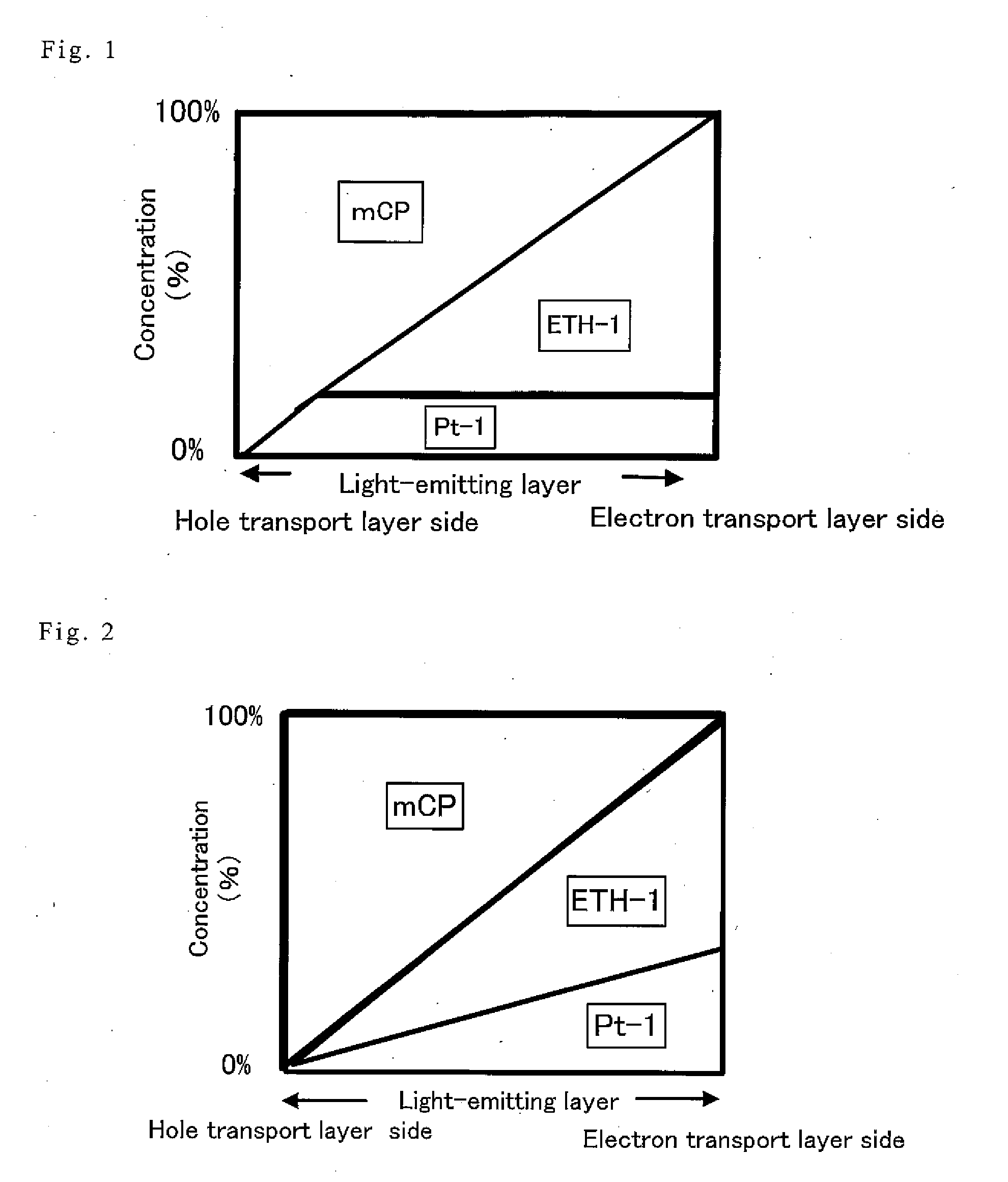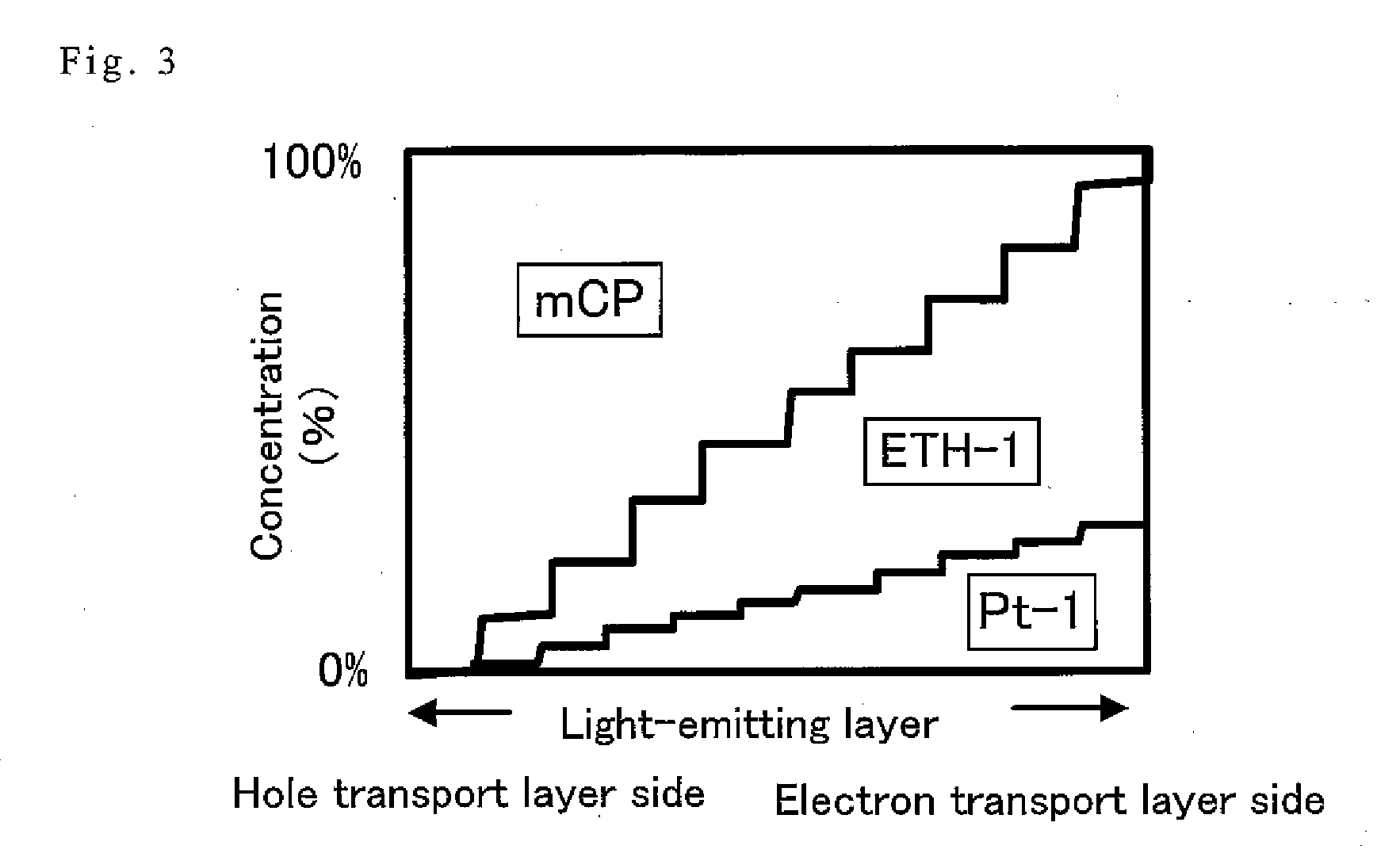Organic electroluminescence element
- Summary
- Abstract
- Description
- Claims
- Application Information
AI Technical Summary
Benefits of technology
Problems solved by technology
Method used
Image
Examples
example 1
1. Preparation of Organic EL Element
[0501](Preparation of Comparative Organic EL Element No. 1)
[0502]A glass substrate (manufactured by Geomatec Co., Ltd., surface electric resistance: 10 Ω / □, size: 0.5 mm in thickness and 2.5 cm square) having a deposited layer of indium-tin oxide (which is hereinafter referred to as ITO) was placed in a cleaning vessel, subjected to an ultrasonic cleaning in 2-propanol and then subjected to an UV-ozone treatment for 30 minutes. On this transparent anode, the following layers were deposited in accordance with a vacuum deposition method. In the examples of the invention, the deposition rate is 0.2 nm / sec unless specified otherwise. The deposition rate was measured using a quartz-crystal oscillator. Also film thicknesses described in the following were measured using a quartz-crystal oscillator.
[0503]Hole Injection Layer:
[0504]4,4′,4″-tris(2-naphthylphenylamino)triphenylamine (which is hereinafter referred to as 2-TNATA) and tetrafluorotetracyanoquin...
example 2
1. Preparation of Organic EL Element
[0534](Preparation of Comparative Organic EL Element No. 4)
[0535]Preparation of comparative organic EL element No. 4 was conducted in a similar manner to the process in the preparation of the comparative organic EL clement No. 1, except that, in the comparative organic EL element No. 1, mCP included in the light-emitting layer was changed to mCP derivative A.
[0536](Preparation of Inventive Organic EL Element No. 3)
[0537]Preparation of inventive organic EL element No. 3 was conducted in a similar manner to the process in the preparation of the inventive organic EL element No. 2, except that, in the inventive organic EL element No. 2, mCP included in the light-emitting layer was changed to the mCP derivative A.
[0538]Chemical structure of the compound used in Examples is shown below.
2. Performance Evaluation and Results
[0539]Driving voltage, external quantum efficiency and drive durability of the obtained comparative organic EL element and inventive ...
example 3
1. Preparation of Organic EL Element
[0541](Preparation of Comparative Organic EL Element No. 5)
[0542]Preparation of comparative organic EL element No. 5 was conducted in a similar manner to the process in the preparation of the comparative organic EL element No. 1, except that, in the comparative organic EL element No. 1, mCP included in the light-emitting layer was changed to host material 1.
[0543](Preparation of Inventive Organic EL Element No. 4)
[0544]Preparation of inventive organic EL element No. 4 was conducted in a similar manner to the process in the preparation of the inventive organic EL element No. 2, except that, in the inventive organic EL element No. 2, mCP included in the light-emitting layer was changed to the host material 1.
[0545]Chemical structure of the compound used in Examples is shown below.
2. Performance Evaluation and Results
[0546]Driving voltage, external quantum efficiency and drive durability of the obtained comparative organic EL element and inventive or...
PUM
 Login to View More
Login to View More Abstract
Description
Claims
Application Information
 Login to View More
Login to View More - R&D
- Intellectual Property
- Life Sciences
- Materials
- Tech Scout
- Unparalleled Data Quality
- Higher Quality Content
- 60% Fewer Hallucinations
Browse by: Latest US Patents, China's latest patents, Technical Efficacy Thesaurus, Application Domain, Technology Topic, Popular Technical Reports.
© 2025 PatSnap. All rights reserved.Legal|Privacy policy|Modern Slavery Act Transparency Statement|Sitemap|About US| Contact US: help@patsnap.com



